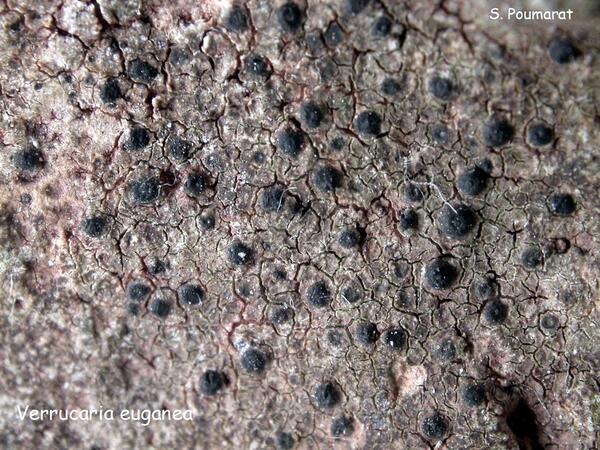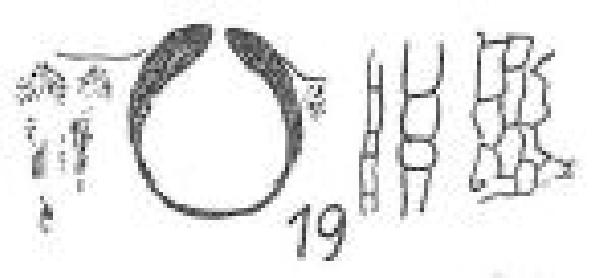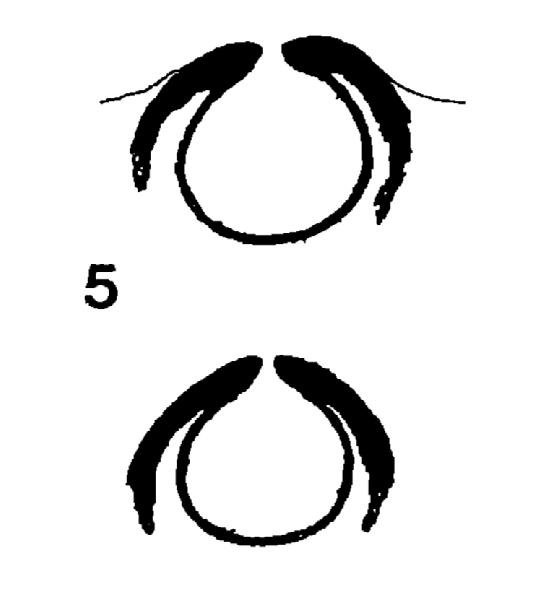Verrucaria euganea Trevis.
Spighe e Paglie: 19, 1853.
Synonyms: Verrucaria obductilis var. reticulata B. de Lesd.
Distribution: N - Ven (Breuss 2008b, Breuss & Berger 2010).
Description: Thallus crustose, episubstratic, 0.15-0.3 mm thick, rimose-areolate, pale to medium brown, with an olive-green hue when wet, forming patches several cm in diam., the areoles 0.3-0.9 mm wide, uneven, rounded or angular, with wavy margins. Cortex 8-25 μm thick; algal layer 80-130 μm thick; medulla white to patchily brownish, often containing rock particles. Perithecia black, sparse, c. 10-15/cm², hemispherically projecting from the areoles, the flanks covered by a thin thalline layer, the apical part naked, 0.3-0.5 mm across. Involucrellum reaching down at least half of the perithecium (often to base), forming an arch above the exciple, well-separated by an undifferentiated tissue, c. 50-80 μm thick, sometimes slightly thinner at the base; exciple globose, (0.35-)0.5-0.7 mm across, the wall 35-45 μm thick, brown to blackish brown; hamathecium of branched and anastomosing, 70-100 μm long periphyses and periphysoids, interascal filaments absent; hymenial gel hemiamyloid, I+ red (I+ blue at very low concentrations of I), K/I+ blue. Asci 8-spored, clavate, I-, fissitunicate, the wall thickened above, with an ocular chamber, dehiscent by extrusion of an endotunica to form a delicate rostrum, Verrucaria-type. Ascospores 1-celled, hyaline, ellipsoid, 27-35 x 14-17 μm. Photobiont chlorococcoid. Spot tests: K-, C-, KC-, P-, UV-. Chemistry: without lichen substances.Note: an early coloniser of walls (mortar, brick, cement, limestone) in urban settlements; related to V. macrostoma, but differing in several important morphological characters (see Breuss 2008b, Breuss & Berger 2010); probably more widespread.
Growth form: Crustose
Substrata: rocks
Photobiont: green algae other than Trentepohlia
Reproductive strategy: mainly sexual
In underhangs rarely wetted by rain
Pioneer species
Poorly known taxon in need of further study
Commonnes-rarity: (info)
Alpine belt: absent
Subalpine belt: absent
Oromediterranean belt: absent
Montane belt: rare
Submediterranean belt: rare
Padanian area: absent
Humid submediterranean belt: very rare
Humid mediterranean belt: common
Dry mediterranean belt: absent

Predictive model
Growth form: Crustose
Substrata: rocks
Photobiont: green algae other than Trentepohlia
Reproductive strategy: mainly sexual
In underhangs rarely wetted by rain
Pioneer species
Poorly known taxon in need of further study
Commonnes-rarity: (info)
Alpine belt: absent
Subalpine belt: absent
Oromediterranean belt: absent
Montane belt: rare
Submediterranean belt: rare
Padanian area: absent
Humid submediterranean belt: very rare
Humid mediterranean belt: common
Dry mediterranean belt: absent

Predictive model
 INDEX FUNGORUM
INDEX FUNGORUM
 GBIF
GBIF
 DOLICHENS
DOLICHENS




